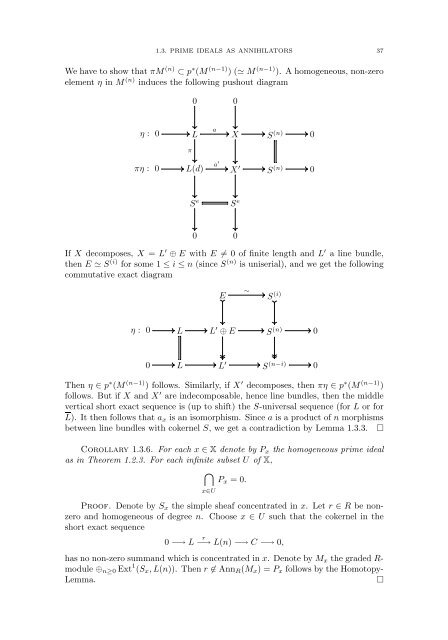MEMOIRS
MEMOIRS
MEMOIRS
- No tags were found...
You also want an ePaper? Increase the reach of your titles
YUMPU automatically turns print PDFs into web optimized ePapers that Google loves.
1.3. PRIME IDEALS AS ANNIHILATORS 37We have to show that πM (n) ⊂ p ∗ (M (n−1) )(≃ M (n−1) ). A homogeneous, non-zeroelement η in M (n) induces the following pushout diagram0 0η : 0LaX S (n) 0ππη : 0L(d)a ′ X ′ S (n) 0S eS e0 0If X decomposes, X = L ′ ⊕ E with E ≠ 0 of finite length and L ′ a line bundle,then E ≃ S (i) for some 1 ≤ i ≤ n (since S (n) is uniserial), and we get the followingcommutative exact diagramE∼S (i)η : 0 L L ′ ⊕ E S (n) 00 L L ′ S (n−i) 0Then η ∈ p ∗ (M (n−1) ) follows. Similarly, if X ′ decomposes, then πη ∈ p ∗ (M (n−1) )follows. But if X and X ′ are indecomposable, hence line bundles, then the middlevertical short exact sequence is (up to shift) the S-universal sequence (for L or forL). It then follows that a x is an isomorphism. Since a is a product of n morphismsbetween line bundles with cokernel S, we get a contradiction by Lemma 1.3.3. □Corollary 1.3.6. For each x ∈ X denote by P x the homogeneous prime idealas in Theorem 1.2.3. For each infinite subset U of X,⋂P x =0.x∈UProof. Denote by S x the simple sheaf concentrated in x. Letr ∈ R be nonzeroand homogeneous of degree n. Choose x ∈ U such that the cokernel in theshort exact sequence0 −→ L −→ rL(n) −→ C −→ 0,has no non-zero summand which is concentrated in x. DenotebyM x the graded R-module ⊕ n≥0 Ext 1 (S x ,L(n)). Then r ∉ Ann R (M x )=P x follows by the Homotopy-Lemma.□
















